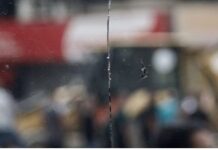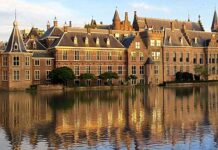Brian Osgood
Al-Jazeera / May 15, 2023
For Palestinians living in the United States, memories of the 1948 ‘catastrophe’ sit alongside frustration with US policy.
Los Angeles, United States – Leila Giries was eight years old when she fled with her family from Ayn Karim, a Palestinian village on the outskirts of Jerusalem, during the creation of the Israeli state and violent expulsion of more than 750,000 Palestinians in 1948.
More than seven decades later, her memories remain vivid: families rushing to pack their most vital belongings, prayers as a truck full of refugees drove along a cliffside road, the searing pain of her mother using a flaming piece of cloth to cauterize an open wound when she stepped on a nail.
“We fled on foot. We had only the clothes on our back,” Giries, who now lives in a suburb of Los Angeles in the US state of California, recalled in a recent phone call with Al-Jazeera. “The sky was lit up with the fire of the guns. It felt like the end of the world.”
The world of Leila’s childhood, of Ayn Karim as a vibrant Palestinian community where people greeted her in the street and children played among rows of almond trees, was shattered alongside Palestinian society in the violence of 1948.
For Palestinians, that year represents the beginning of decades of ongoing violence and dispossession, referred to simply as Al-Nakba – the catastrophe.
Violent expulsion
Giries’s experience is not unique. Indeed, she is quick to add that every Palestinian family has a story like hers, memories of displacement and exile that continue to resonate.
“1948 is a crucible where many of the elements of Palestinian identity as we understand it today are formed,” Rashid Khalidi, a professor of Arab Studies at Columbia University and the author of several books on Palestine, told Al-Jazeera in a recent phone call. “It’s indelible in the consciousness of Palestinians and much of the Arab world.”
Abandoned remnants of former Palestinian communities are scattered across the landscape of modern Israel, quiet reminders of the more than 400 cities and villages that were depopulated to make way for the creation of a Jewish state on land where, in 1948, a large majority of the population was Palestinian.
As villages were levelled by Israeli forces to prevent Palestinians from returning home, refugee camps sprung up to accommodate their displaced inhabitants.
Today, the United Nations estimates there are nearly 6 million Palestinian refugees, about a quarter of whom continue to live in 58 UN-recognized camps scattered across the region from Gaza to Jenin, East Jerusalem to Jordan, southern Lebanon to Syria.
Khalidi notes that on top of the trauma of expulsion, the events of 1948 were a devastating blow to Palestinian society, fracturing existing bonds and organizations.
“The depopulation of places like Jaffa and Haifa cuts the heart out of Arab civil society in Palestine,” he said. “It makes reorganization that much harder.”
‘Everything I loved is gone’
Giries’s story differs in one crucial way from those of many others: After time in Jordan and Iraq, she and her family were able to move to the United States in 1958.
“In Baghdad, I had to stand up in school and say that I was a refugee,” she said. “I felt proud when I received a US passport because I was no longer stateless.”
The passport has also allowed her to visit her former home, a dream that remains tantalizingly out of reach for many Palestinians.
But the experience has been bittersweet: The Ayn Karim she remembers no longer exists.
“I can’t keep Palestine out of my heart. As long as I’m alive, I will go back,” Giries said.
“But now when I visit Ayn Karim, it’s not the same. My family is not there. … When I walk down the street, nobody knows me. They did not just rob me of my land, they robbed me of my memory. Everything I loved is gone. I see my old home and it is just a pile of rubble,” she said.
Michael Kardoush, a Palestinian who has lived in the US for more than 50 years, left his home in Nazareth in 1954 and walked 18km (11 miles) across the border to Lebanon. He said it was preferable to living under the military rule that Israel applied to Arabs living within its borders until 1966.
“You are still living in the same place, but you ask yourself, ‘Is this still my home? Is the air mine? Is the sky mine?” Kardoush, who now lives in Houston, Texas, told Al Jazeera over the phone. “To live under occupation is unbearable. I wanted to live again.”
Kardoush pursued his studies as an engineer in Egypt before eventually finding work in Germany and then, in 1969, in the United States, where he moved into an apartment near the ocean in Los Angeles.
For years, Kardoush said, he used his US passport to visit home with no issues. But in 2006, he arrived at the Tel Aviv airport and was told that a new law stipulated that he could only enter with an Israeli passport since he had been born in a city that is now part of Israel.
He says he sent all of the necessary documents but has not received a response 17 years later.
“I have a big family,” he said. “There are a lot of weddings, and it is painful that I can’t be there. Now I will never go back.”
US involvement
Giries and Kardoush said they have been fortunate to make good lives for themselves in the US. But for many years, they say most Americans had little understanding of the Palestinian experience.
“All the time, when people heard our story, they didn’t understand,” Giries said.
The US is Israel’s most vital ally, providing about $3.8bn in assistance to help Israel maintain a powerful military edge in the region. In US politics, a formidable number of advocacy organizations promote robust support for the Jewish state and lead efforts to oppose lawmakers who call for placing conditions on or reducing US aid.
“The war on Palestine is a joint enterprise,” Khalidi said. “You have American weapons, you have the US in the Security Council, you have collaboration and coordination and collusion at every stage since 1967.”
But Giries says that over the past several years, she has noticed a change: For the first time she can remember, she is seeing more sympathy for the plight of Palestinians and awareness of their history.
In March, a YouGov/Economist poll found that, for the first time, Democratic voters said they sympathised more with Palestinians than with Israelis by a small margin of 21 to 19 percent.
“I’ve been in this house for more than 30 years, and this last year was the first time I was able to explain things to my church group and for them to be receptive and understand,” Giries said. “But I don’t think in my lifetime I will see peace in Palestine. I wish that I could see peace. I wish I could see them [Jews and Palestinians] living together.”
In her home in Los Angeles, a small bag her mother carried while fleeing Ayn Karim is framed on the wall, a symbol of the feelings of exile and connection to her homeland that remain vivid all these years later.
“Sometimes your mind finds ways to protect you from bad memories,” she said. “But the minute the car starts taking me down the road to Ayn Karim, my heart starts to beat.”
“Next time I go,” she said. “I will take a piece of my home’s rubble.”
Brian Osgood is a reporter working in Southern California












